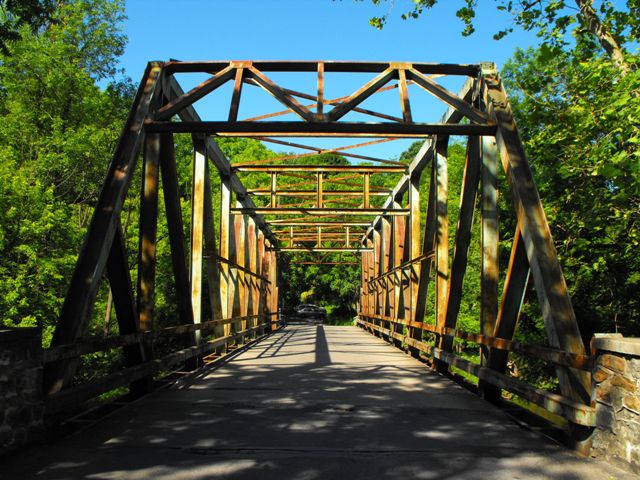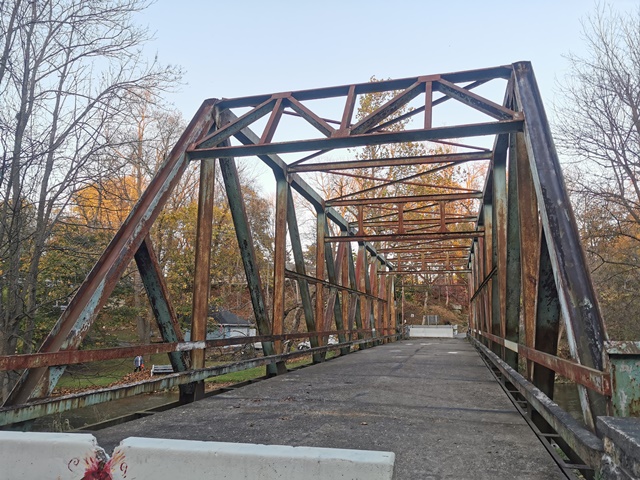We Recommend:
Bach Steel - Experts at historic truss bridge restoration.
BridgeHunter.com Phase 1 is released to the public! - Visit Now
High Street Bridge
Seidersville Road Bridge

Primary Photographer(s): Nathan Holth and Rick McOmber
Bridge Documented: May 30, 2010 and November 2, 2019
Near Hellertown: Northampton County, Pennsylvania: United States
Not Available or Not Applicable
131.0 Feet (39.9 Meters)
134.8 Feet (41.1 Meters)
18 Feet (5.49 Meters)
1 Main Span(s)
48730100009019

View Information About HSR Ratings
Bridge Documentation
View Archived National Bridge Inventory Report - Has Additional Details and Evaluation
This bridge is the only known through truss with welded connections in Pennsylvania. Constructed in 1935, the bridge is one of the earliest all-welded truss bridges in Pennsylvania. For these two reasons, the bridge is considered technologically significant and the bridge is thus eligible for the National Register of Historic Places., because it documents the transition from riveted connections to welded connections. The bridge also represents a transition from built-up beams to all-rolled beams in truss bridge construction, since the majority of bridge's members are composed of rolled beams with no riveting or welding. Some elements are built-up with welds, such as the bottom chord. The bridge also makes considerable use of wide flange beams, also called H sections, which became the standard after the traditional American Standard Beam i-beam fell from favor because of its troublesome sloped flanges. All of these features: the welds, the wide flange beams, and the heavy use of rolled beams, were all new for use in bridge construction when this bridge was built. What is interesting is how similar this 1935 bridge is to modern welded truss bridges built today in some states such as Ohio. Unlike other bridge types which often evolved and changed a lot over the years and decades, the welded truss bridge has changed very little in design and appear since it began to be used. The 1935 bridge also shares another trait with modern bridges: it is visually ugly. The excessive use of rolled beams and the simple, plain welded connections have removed the intricate complexity that can be seen in a traditional historic riveted or pinned truss bridge, leaving a bridge with an extremely plain and overly imposing appearance. It may be quite a shock to encounter a historic bridge that is so unappealing visually, since during this period in history, much greater attention was usually given to the aesthetic value of a bridge than is done today, and further some of the utilitarian practices of the time like riveting and lattice on built-up beams for example, are aesthetically pleasing in today's world of mundane pre-stressed concrete slab bridges. It is important to remember however that while normally aesthetic value and historic significance normally go hand in hand with historic bridges, there are sometimes cases where a historic bridge may not be the most visually appealing structure. However, the bridge is still a part of our transportation heritage and it helps explain how we got to where we are today in terms of bridge construction.
Information and Findings From Pennsylvania's Historic Bridge InventoryDiscussion of Bridge The single span, 135'-long, 9 panel, welded, Pratt thru truss bridge is supported on stone abutments with concrete bridge seats. The members are composed of rolled I and H sections. The bridge ranks as one of the early, all-welded bridges in the state, and it is technologically significant representing the transition from riveted to welded connections in bridge fabrication. The bridge is one of about a dozen identified welded off-system truss bridges built in Pennsylvania. Most predate World War II, and it is the only identified welded thru truss bridge in the state. Discussion of Surrounding Area The bridge carries a 2 lane road over a stream in a forested setting with modern houses. The area does not have historic district potential. Bridge Considered Historic By Survey: Yes |
This bridge is tagged with the following special condition(s): Unorganized Photos
![]()
Photo Galleries and Videos: High Street Bridge
Bridge Photo-Documentation
Original / Full Size PhotosA collection of overview and detail photos. This gallery offers photos in the highest available resolution and file size in a touch-friendly popup viewer.
Alternatively, Browse Without Using Viewer
![]()
Bridge Photo-Documentation
Mobile Optimized PhotosA collection of overview and detail photos. This gallery features data-friendly, fast-loading photos in a touch-friendly popup viewer.
Alternatively, Browse Without Using Viewer
![]()
Eastbound Crossing of the Bridge
Full Motion VideoStreaming video of the bridge. Also includes a higher quality downloadable video for greater clarity or offline viewing.
![]()
Westbound Crossing of the Bridge
Full Motion VideoStreaming video of the bridge. Also includes a higher quality downloadable video for greater clarity or offline viewing.
![]()
Additional Unorganized Photos
Original / Full Size PhotosA supplemental collection of photos that are from additional visit(s) to the bridge and have not been organized or captioned. This gallery offers photos in the highest available resolution and file size in a touch-friendly popup viewer.
Alternatively, Browse Without Using Viewer
![]()
Additional Unorganized Photos
Mobile Optimized PhotosA supplemental collection of photos that are from additional visit(s) to the bridge and have not been organized or captioned. This gallery features data-friendly, fast-loading photos in a touch-friendly popup viewer.
Alternatively, Browse Without Using Viewer
![]()
Maps and Links: High Street Bridge
Coordinates (Latitude, Longitude):
Search For Additional Bridge Listings:
Bridgehunter.com: View listed bridges within 0.5 miles (0.8 kilometers) of this bridge.
Bridgehunter.com: View listed bridges within 10 miles (16 kilometers) of this bridge.
Additional Maps:
Google Streetview (If Available)
GeoHack (Additional Links and Coordinates)
Apple Maps (Via DuckDuckGo Search)
Apple Maps (Apple devices only)
Android: Open Location In Your Map or GPS App
Flickr Gallery (Find Nearby Photos)
Wikimedia Commons (Find Nearby Photos)
Directions Via Sygic For Android
Directions Via Sygic For iOS and Android Dolphin Browser
USGS National Map (United States Only)
Historical USGS Topo Maps (United States Only)
Historic Aerials (United States Only)
CalTopo Maps (United States Only)



